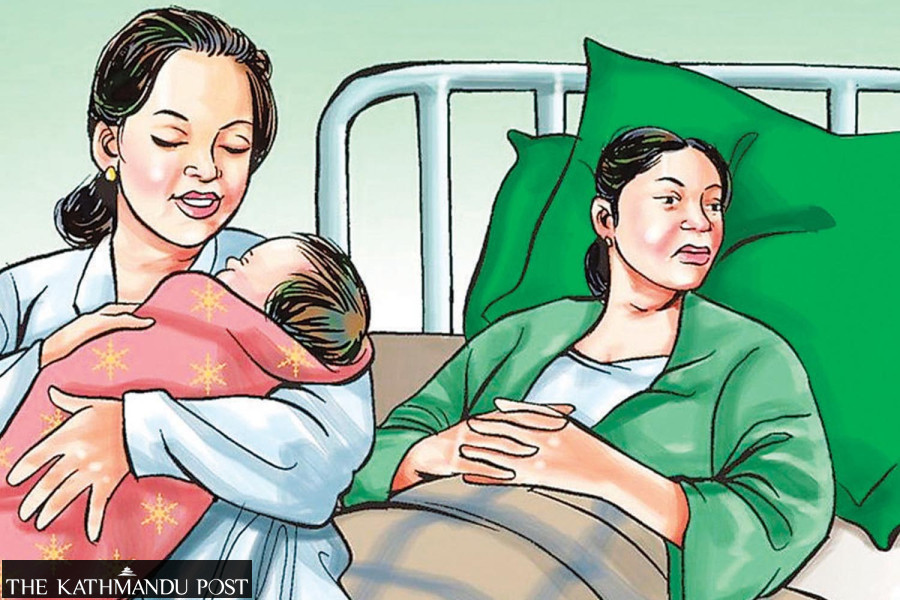Health
Nepal sees sharp drop in hospital births
Experts say the country may have to revise its population policy if birth and fertility rates keep falling.
Arjun Poudel
In fiscal year 2024-25, a total of 20,900 women gave birth at Thapathali-based Paropakar Maternity and Women’s Hospital. The figure was 22,379 in the previous fiscal year, and over 24,000 in fiscal year 2021-22.
Similarly, Patan Hospital recorded 4,746 births in the last fiscal year, down from 5,223 in the fiscal year 2023-24, and 6,253 in 2022-23. Data from birthing centres run by Patan Hospital also show a sharp decline in birth rates—from 155 three years ago to 92 in the fiscal year 2023-024, and 53 in the last fiscal year.
Health ministry’s data show a sharp nationwide drop in institutional deliveries—from 80 percent to 74 percent in just one year—which experts say could signal changing fertility patterns and pose challenges for Nepal’s maternal health programmes. If this downward trend continues, experts say, Nepal may need to change its population policies.
Similarly, Bharatpur Hospital in Chitwan shows a similar downward trend. In the last fiscal year, 8,266 women gave birth at the hospital, compared to 9,355 in the fiscal year 2023-24, 11,894 in 2022-23, and 12,221 in 2021-22.
All aforementioned hospitals are major maternity hospitals and referral centers. Data provided by those hospitals show a clear decline in deliveries.
It would be logical to attribute the mushrooming of health facilities and birthing centres to the declining delivery rate at major hospitals, but that is not the case, according to doctors.
“Most cases we handle in our hospitals are referral cases,” said Dr Shree Prasad Adhikari, director at the Paropakar Maternity and Women’s Hospital. “There could be multiple reasons for the decline in delivery rate in our hospital, one being that fewer women are being referred over the years.”
Along with hospital data, figures from the Integrated Health Information Management System (IHIMS) under the Department of Health Services, which monitors institutional deliveries nationwide, show that institutional deliveries in Nepal have declined to 74 percent in the fiscal year 2024-25, a sharp decrease from 80 percent in the previous fiscal year.
Institutional delivery and delivery by skilled birth attendants or skilled health professionals is the country’s priority programme, which is credited with curbing maternal and child mortality rates.
Nepal has reduced maternal deaths by over 70 percent since 2000, according to a new report by the World Health Organisation. The UN health body, in its recent report, stated that currently 142 Nepali women die from maternity-related complications per 100,0000 live births. A previous study, carried out by the National Statistics Office in 2021, showed 151 maternal deaths per 100,000 live births.
Similarly, neonatal mortality now stands at 16.6 per 1,000 live births, and the stillbirth rate has decreased to 13.5 per 1,000 births, according to the UN health body. The Nepal Demographic and Health Survey-2022, carried out by the Ministry of Health and Population, showed that 21 neonates die per 1,000 live births.
Health officials say that even if the institutional delivery rate has declined alarmingly, that does not mean the home delivery rate has increased.
“The decline in the overall fertility rate could be the reason for the decline in the institutional delivery rate,” said Nisha Joshi, a public health officer at the Family Welfare Division under the Department of Health Services. “We arrived at the percentage of institutional delivery from the attributed total pregnancies.”
The Total Fertility Rate (TFR) had declined to 1.94 in 2021, and is estimated to be 1.76 in 2025.
Health officials say hospitals providing maternity services nationwide report declining delivery rates.
Maternal health experts attribute multiple factors, including the availability of quality services at the local level, decline in overall pregnancy rate due to internal and external migration of spouse or both, preference for a single child or no child, as possible reasons for the decline in birth rate at health facilities.
“The decline in birth rate and institutional delivery rate requires in-depth study,” said Dr Bishnu Prasad Chaulagain, a maternal and child health expert. “If the trend continues, Nepal may need to reconsider its population policy.”
The IHIMS report shows there were 190 maternal deaths and 1,907 perinatal deaths in the fiscal year 2023-24, with notable provincial variations. Perinatal deaths are deaths of babies between 22 weeks of gestation and before the first seven days of life.
With the government announcing free institutional delivery service in 2009 at all state-run health facilities, more than 2,800 birthing centres have opened across the country. The institutional delivery rate, which was around 18 percent then, has increased to around 80 percent.
Various programmes, including free delivery and travel allowances for those opting for institutional delivery and antenatal visits, have been initiated to reduce maternal mortality. The health ministry has imparted skilled birth attendant (SBA) training to staff nurses and hired them at birthing centres to prevent possible deaths during or after child delivery.
It has also distributed misoprostol, a medication used to treat postpartum bleeding in new mothers, through female community health volunteers.
Nepal had reduced the maternal mortality rate from 539 per 100,000 births in 1996 to 239 per 100,000 births in 2016—for which the country even received a Millennium Development Goals award.
Nepal’s target under the UN’s Sustainable Development Goals is to cut the maternal mortality rate to 75 per 100,000 births by 2030.




 9.12°C Kathmandu
9.12°C Kathmandu













%20(1).jpg&w=300&height=200)
